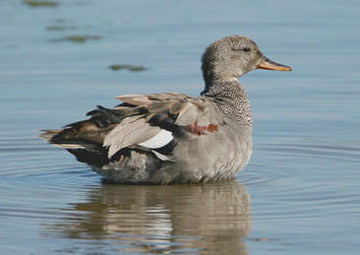
Gadwall © Simon Booth
Recent recruits to birdwatching are amazed to learn that Gadwalls had never bred in Cheshire until 1981, when they first nested at Woolston, but they are now widespread along the inner Mersey valley, and steadily spreading from there to other suitable waters. Probably all of the birds breeding in Britain derive from man’s intervention. The first nesting in England was in the mid 19th century in Norfolk, when a wild wintering pair was trapped, pinioned and later released to breed. These acted as the nucleus of a growing population, but the species did not spread beyond East Anglia. In the mid 20th century, birds started breeding at a variety of sites elsewhere, mostly near to wildfowl collections, and wildfowlers released captive-reared birds as well. The origin of the Cheshire birds is not known, but could be the Wildfowl and Wetlands Trust’s centre at Martin Mere in Lancashire.
Whatever their source, Gadwalls have found several sites in the county to their liking, and the population is steadily growing. This is still a scarce species nationally, and its numbers are monitored by the Rare Breeding Birds Panel. In 2004, the Cheshire and Wirral population was reported to the RBBP as 31 pairs, clearly an under-estimate, out of a national total of 1520 pairs (Holling et al 2007). Most of the county’s birds are at Woolston: at least 20 broods from an estimated minimum of 30 pairs; 20 broods again in 2005 and 15-17 broods in 2006.
Gadwalls forage almost exclusively on the green parts of plants, particularly emergent and subemergent macrophytes. This food is of such poor nutritional quality that they have to eat vast amounts, so the ducks have to be able to feed undisturbed for long periods, and have access to lots of the plant material, so they tend only to breed in areas where the biomass of food plants is high, predominantly in eutrophic waters. On deeper waters, such as gravel pits and reservoirs, Gadwall steal food from Coots which bring up macrophytes from deeper water normally inaccessible to the dabbling Gadwall, and food obtained in this way can account for such a high proportion of their intake that this habit has allowed them to colonise waters that would otherwise be unsuitable for them. Kleptoparasitism from Coots does not seem to have been recorded in Cheshire and Wirral, however, and it would be interesting to record its occurrence and spread.
In this survey, Gadwalls were reported using a range of wet habitats: two-thirds were on lakes, reservoirs and sand quarries, but one pair was on a small pond in Tatton Park (SJ78L) and in six tetrads they were using small waterbodies, two of them holding broods of chicks. Breeding birds were also found on the river Weaver Bend (SJ57E) and at two sites on the Manchester Ship Canal, although perhaps the birds had nested elsewhere nearby. Four were found in wet grassland (C6, C7, C9) including, unusually, a pair on a Dee saltmarsh pool; they are almost invariably birds of freshwater. The actual nesting site may be well away from water, however: nests at Woolston have frequently been found in the dry centre of no.4 bed, about 500 m from water. The females lead their chicks to the pools, with the first hatching from about late May, and new broods of chicks still being seen into early July.
Sponsored by James Coyne

